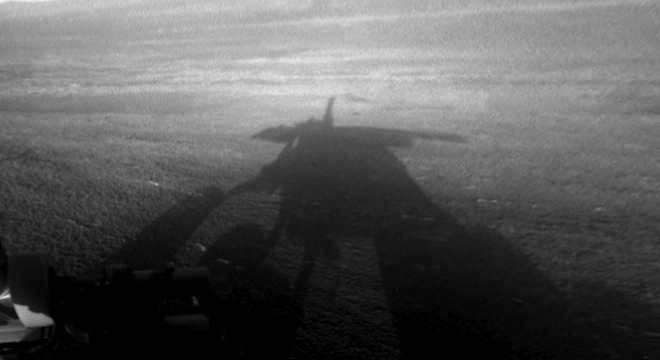Call it the little rover that could: NASA’s Opportunity Mars Rover, which landed on the Red Planet on January 24, 2004, is still going strong after nine years of continuous operations and counting, the agency announced this week.
Opportunity’s longevity is all the more impressive considering its original mission was only supposed to last three months, and that an identical twin rover, Spirit, which landed on Mars three weeks earlier, ceased communications in 2011 after getting irreversibly stuck in loose Martian soil in May 2009.
“The two rovers were built to be essentially identical and to operate for at least three months on Mars,” wrote John Callas, project manager of the Mars Exploration Rover program at NASA’s Jet Propulsion Laboratory in Pasadena, California. “Both far exceeded that goal.”
But now it is Opportunity that it is the only one of the duo still functioning, and pure chance could have played a role in its fate, as Callas explained.
“It may have been chance that wore out the drive motors on two of Spirit’s six wheels before any wore out on Opportunity,” Callas wrote, “but the hilly, rocky terrain that Spirit traversed might also have been a factor.”
Ultimately, it was a combination of factors — some technical and some purely circumstantial — that led Opportunity to outlast its sibling:
“Eventually, losing the use of two wheels prevented Spirit from having mobility to gain a favorable sun-facing tilt for the Martian winter. Spirit’s site is farther from the equator than Opportunity’s, so that maintaining a safe energy level during the winter was more of a challenge for Spirit. ”
That energy level difference is due to the power source on both rovers — solar photovoltaic cells, “supplemented for some localized heating by eight radioisotope heater units,” as Callas pointed out to TPM.
The harsh, dust-filled environment of Mars — where enormous dust storms are a regular occurrence — made getting reliable solar power for both rovers a challenge, especially as more time passed. But Martian weather has also helped clean the Opportunity rover’s solar panels, too.
“The amount of electricity produced daily by the photovoltaic array can vary with the amount of dust in the atmosphere and the amount of dust accumulating on the surface of the array,” Callas said. “Several times during the mission, winds have cleaned some of the accumulated dust off the array, boosting the array’s electrical output.”
Despite that, the Opportunity rover’s total electricity generation is currently “less than half of what it was when Opportunity first landed,” Callas noted.
Check out the following self-portrait Opportunity took in late 2011, a photo-mosaic clearly showing the accumulated dust on its solar panels:

NASA, too, played a role in extending the rover past its intended working lifetime, “by using care every day in operating the rover safely,” according to Callas.
Opportunity will for the coming weeks continue investigating outcrops in a giant 14-mile wide crater known as Endeavour for clues about the ancient environment of Mars, NASA explained in a news release. Opportunity first reached the rim of this crater in August 2011.
Check out an image of the site below, via NASA:

In total, Opportunity has traveled some 22.03 miles so far, well beyond the 2,000 feet initially planned. It’s also visited some 12 separate craters around a region near the Martian equator known as Meridiani Planum, and made a number of important scientific discoveries, including evidence that water flowed on Mars, which it uncovered in its first three months on the surface.
The region that Opportunity is presently exploring appears to have been a much wetter and less acidic environment than were found in earlier observations.
“As long as Opportunity continues to function, the science team for Opportunity will continue to use the rover to learn more about the history of wet environments on Mars,” Callas said. “The arrival at Endeavour crater presents the rover with new geology from an earlier epoch on Mars, allowing the rover to assess the planet’s habitability even earlier in its history.”
Opportunity’s still-working mast camera and robotic arm instruments will come in handy for its upcoming exploration. But it’s anyone’s guess for how long the rover will run. Not even NASA’s Callas would speculate, telling TPM the rover could go dark any day.
“Opportunity is well past its design life in a harsh working environment,” Callas said. “Any of several essential components could stop working tomorrow and end the mission, or the rover might keep operating for additional years. It is impossible to say how much longer it will run. The only thing that can be said is that with each passing day, we are one day closer to that end.”
To celebrate the nine-year milestone, NASA this week released the following full-color panorama of the rover’s current site. See it below and here at NASA’s JPL website.







